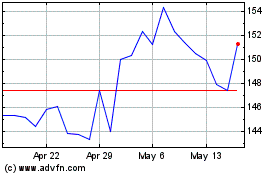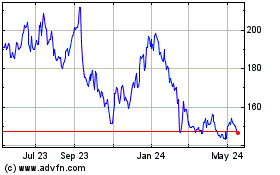Alnylam Pharmaceuticals, Inc. (Nasdaq: ALNY), the leading RNAi
therapeutics company, today announced that the Company will present
data from its transthyretin amyloidosis (ATTR) and hypertension
programs at the upcoming American Heart Association (AHA)
Scientific Sessions 2024, November 16–18, 2024.
Data presentations for the Company’s flagship TTR franchise
include new findings from an analysis of the HELIOS-B Phase 3 study
of vutrisiran, an RNAi therapeutic in development for the treatment
of ATTR amyloidosis with cardiomyopathy (ATTR-CM), as well as
interim results from a Phase 1 study evaluating ALN-TTRsc04, a next
generation RNAi therapeutic in development for the treatment of
ATTR amyloidosis. Full results from the HELIOS-B study, the largest
and most contemporary ATTR-CM study to date, were published in The
New England Journal of Medicine earlier this year. The study
achieved all 10 pre-specified primary and secondary endpoints. In
addition, the Company will present a new analysis of the KARDIA-1
Phase 2 study of zilebesiran, an investigational RNAi therapeutic
in development for the treatment of hypertension.
ATTR Abstracts A Phase 1, Single
Ascending Dose Study to Evaluate ALN-TTRsc04, a Next-Generation RNA
Interference Therapeutic, in Healthy Participants for Potential
Treatment of Transthyretin Amyloidosis Poster 4135443: Session:
Cutting Edge Clinical Cardiomyopathies Research (Abstract Oral
Session) Sunday, November 17, 2024, 8:30 a.m. (CST), 9:30 a.m.
(EST) Presenting Author: Ali Murad
Impact of vutrisiran on outpatient worsening heart failure in
patients with transthyretin amyloidosis with cardiomyopathy in the
HELIOS-B trial Poster 4171680: Session: Amyloid, Hypertrophic,
and Danon Cardiomyopathies: Targeted Therapies and Specific
Populations (Featured Science) Monday, November 18, 2024, 10:21
a.m. (CST), 11:21 a.m. (EST) Presenting Author: Marianna
Fontana
Hypertension Abstracts Impact of
Long-Term Blood Pressure Variability on Adverse Cardiovascular
Outcomes in High- and Low-Risk Populations Poster MDP1200:
Session: The Threats of Hypertension to Life and Healthy Organ
Function (Moderated Digital Poster Session) Sunday, November 17,
2024, 10:40 a.m. (CST), 11:40 a.m. (EST) Presenting Author: Lynne
Krohn
Home Blood Pressure Reductions with Zilebesiran in Patients
with Mild-To-Moderate Hypertension are Consistent with Ambulatory
and Office Blood Pressure Reductions in the KARDIA-1 Study
Poster MDP746: Session: Hypertension Gets Exciting! New Drugs! New
Technologies! What Should I Choose? (Moderated Digital Poster
Session) Sunday, November 17, 2024, 3:45 p.m. (CST), 4:45 p.m.
(EST) Presenting Author: Dion Zappe
About AMVUTTRA® (vutrisiran)
AMVUTTRA® (vutrisiran) is an RNAi therapeutic that delivers
rapid knockdown of mutant and wild‑type transthyretin (TTR),
addressing the underlying cause of transthyretin (ATTR)
amyloidosis. Administered quarterly via subcutaneous injection,
AMVUTTRA is approved and marketed in more than 15 countries for the
treatment of the polyneuropathy of hereditary
transthyretin-mediated amyloidosis (hATTR-PN) in adults. Vutrisiran
is also in development for the treatment of ATTR amyloidosis with
cardiomyopathy (ATTR-CM), which encompasses both wild-type and
hereditary forms of the disease. For more information about
AMVUTTRA, including the full U.S. Prescribing Information,
visit AMVUTTRA.com.
About ATTR
Transthyretin amyloidosis (ATTR) is an underdiagnosed, rapidly
progressive, debilitating and fatal disease caused by misfolded
transthyretin (TTR) proteins, which accumulate as amyloid deposits
in various parts of the body, including the nerves, heart and
gastrointestinal tract. Patients may present with polyneuropathy,
cardiomyopathy or both manifestations of disease. There are two
different forms of ATTR – hereditary ATTR (hATTR), which is caused
by a TTR gene variant and affects approximately 50,000 people
worldwide, and wild-type ATTR (wtATTR), which occurs without a TTR
gene variant and impacts an estimated 200,000-300,000 people
worldwide.1-4
About RNAi
RNAi (RNA interference) is a natural cellular process of gene
silencing that represents one of the most promising and rapidly
advancing frontiers in biology and drug development today.5 Its
discovery has been heralded as “a major scientific breakthrough
that happens once every decade or so,” and was recognized with the
award of the 2006 Nobel Prize for Physiology or Medicine.6 By
harnessing the natural biological process of RNAi occurring in our
cells, a new class of medicines known as RNAi therapeutics is now a
reality. Small interfering RNA (siRNA), the molecules that mediate
RNAi and comprise Alnylam’s RNAi therapeutic platform, function
upstream of today’s medicines by potently silencing messenger RNA
(mRNA) – the genetic precursors that encode for disease-causing or
disease pathway proteins – thus preventing them from being made.5
This is a revolutionary approach with the potential to transform
the care of patients with genetic and other diseases.
About Alnylam Pharmaceuticals
Alnylam (Nasdaq: ALNY) has led the translation of RNA
interference (RNAi) into a whole new class of innovative medicines
with the potential to transform the lives of people afflicted with
rare and prevalent diseases with unmet need. Based on Nobel
Prize-winning science, RNAi therapeutics represent a powerful,
clinically validated approach yielding transformative medicines.
Since its founding in 2002, Alnylam has led the RNAi Revolution and
continues to deliver on a bold vision to turn scientific
possibility into reality. Alnylam has a deep pipeline of
investigational medicines, including multiple product candidates
that are in late-stage development. Alnylam is executing on its
“Alnylam P5x25” strategy to deliver transformative medicines in
both rare and common diseases benefiting patients around the world
through sustainable innovation and exceptional financial
performance, resulting in a leading biotech profile. Alnylam is
headquartered in Cambridge, MA. For more information about our
people, science and pipeline, please visit www.alnylam.com
and engage with us on X (formerly Twitter) at @Alnylam, or
on LinkedIn, Facebook, or Instagram.
_________________________
1 Hawkins PN, Ando Y, Dispenzeri A, et al.
Ann Med. 2015;47(8):625-638.
2 Gertz MA. Am J Manag Care.
2017;23(7):S107-S112.
3 Conceicao I, Gonzalez-Duarte A, Obici L,
et al. J Peripher Nerv Syst. 2016;21:5-9.
4 Ando Y, Coelho T, Berk JL, et al.
Orphanet J Rare Dis. 2013;8:31.
5 Elbashir SM, Harborth J, Lendeckel W, et
al. Nature. 2001;411(6836):494-498.
6 Zamore P. Cell.
2006;127(5):1083-1086.
View source
version on businesswire.com: https://www.businesswire.com/news/home/20241030248743/en/
Alnylam Pharmaceuticals, Inc.
Christine Regan Lindenboom (Investors and Media)
+1-617-682-4340
Josh Brodsky (Investors) +1-617-551-8276
Alnylam Pharmaceuticals (NASDAQ:ALNY)
Historical Stock Chart
From Oct 2024 to Nov 2024

Alnylam Pharmaceuticals (NASDAQ:ALNY)
Historical Stock Chart
From Nov 2023 to Nov 2024
